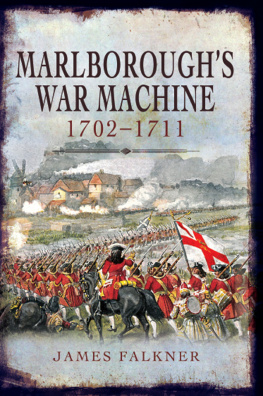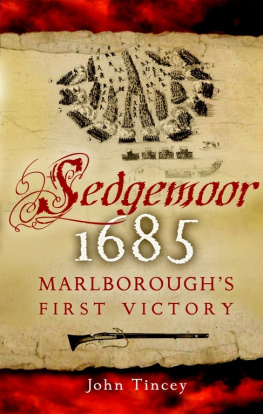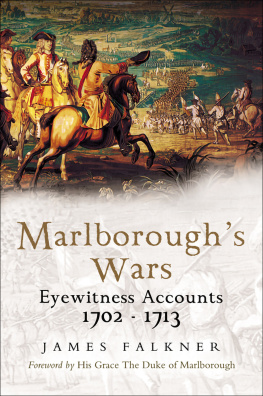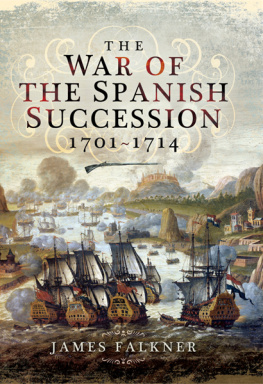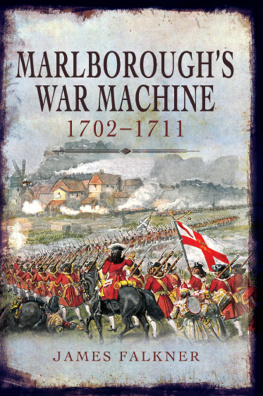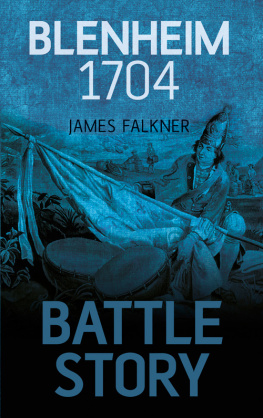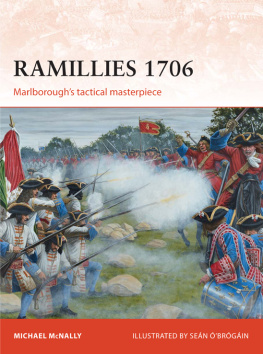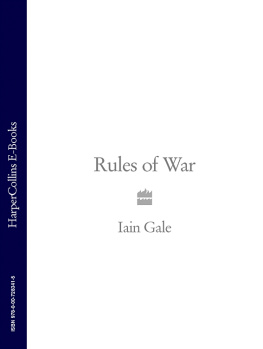Marlboroughs
War Machine
17021711
First published in Great Britain in 2014 by
PEN & SWORD MILITARY
an imprint of
Pen & Sword Books Ltd
47 Church Street
Barnsley
South Yorkshire
S70 2AS
Copyright James Falkner, 2014
ISBN 978-1-84884-821-4
The right of James Falkner to be identified as the author of this work has been asserted by him in accordance with the Copyright, Designs and Patents Act 1988.
A CIP catalogue record for this book is available from the British Library.
All rights reserved. No part of this book may be reproduced or transmitted in any form or by any means, electronic or mechanical including photocopying, recording or by any information storage and retrieval system, without permission from the Publisher in writing.
Typeset by Concept, Huddersfield, West Yorkshire, HD4 5JL. Printed and bound in England by CPI Group (UK) Ltd, Croydon CR0 4YY.
Pen & Sword Books Ltd incorporates the imprints of Pen & Sword Archaeology, Atlas, Aviation, Battleground, Discovery, Family History, History, Maritime, Military, Naval, Politics, Railways, Select, Social History, Transport, True Crime, and Claymore Press, Frontline Books, Leo Cooper, Praetorian Press, Remember When, Seaforth Publishing and Wharncliffe.
For a complete list of Pen & Sword titles please contact
PEN & SWORD BOOKS LIMITED
47 Church Street, Barnsley, South Yorkshire, S70 2AS, England
E-mail:
Website: www.pen-and-sword.co.uk
Contents
Maps
Plates
1. John Churchill, First Duke of Marlborough, by Godfrey Kneller.
2. The Duke of Marlborough at the Battle of Blenheim in 1704.
3. Prince Eugene of Savoy.
4. Henry of Nassau, Veldt-Marshal Overkirk.
5. John Churchill, First Duke of Marlborough.
6. Queen Anne of Great Britain.
7. Louis XIV of France, the Sun King.
8. Louis-Guillaume, Margrave of Baden.
9. Major General William Cadogan.
10. Arnold Joost van Keppel, First Earl Albemarle.
11. Lieutenant General Charles Churchill.
12. George Hamilton, First Earl Orkney.
13. Claude-Louis-Hector de Villers, Marshal of France.
14. Major General Joseph Sabine.
15. Major General Lord John Cutts of Gowran.
16. George, the Elector of Hanover.
17. George, Electoral Prince of Hanover.
18. John Campbell, Red John, Second Duke of Argyll.
19. Major General John Armstrong.
20. Christian Davis (Mother Ross).
21. A blue-coated trooper of the Prussian Lieb Regiment of Dragoons.
22. Donauwrth town seen from the Schellenberg hill.
23. Offuz village near to Ramillies.
24. The Scheldt River near Oudenarde.
25. Marlboroughs army moves to cross the pontoon bridges over the Schedldt River.
26. The Wynendael tapestry from Blenheim Palace.
27. Detail from the Oudenarde tapestry at Blenheim Palace.
28. The desperate fighting in the woods at Malplaquet on 11 September 1709.
29. Marlboroughs cavalry move through the Allied gun-line on the afternoon of Malplaquet.
30. The execution of deserters in the Allied camp, c.1707.
31. Soldiers relax in a sutlers tent while in camp.
32. Siege operations.
33. The armorial bearings of John, First Duke of Marlborough.
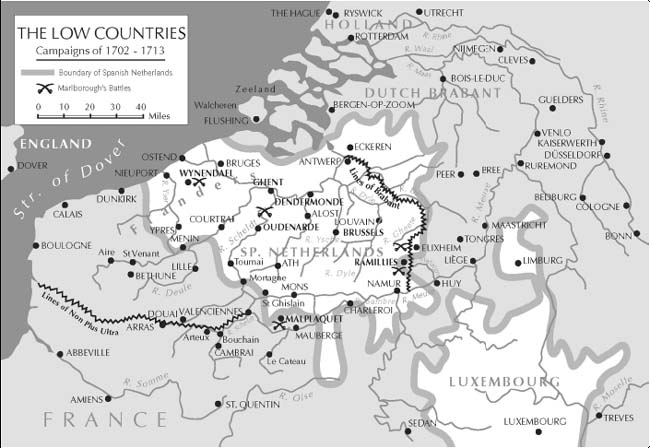
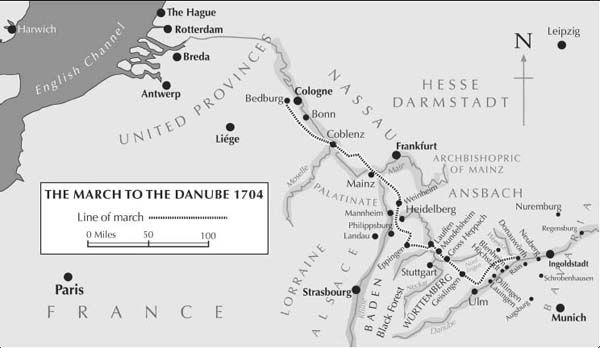
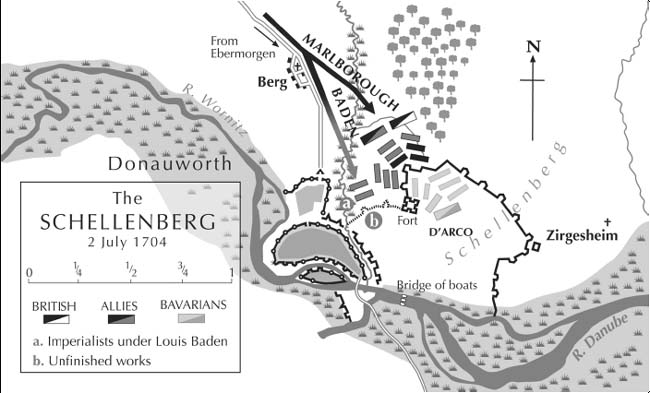
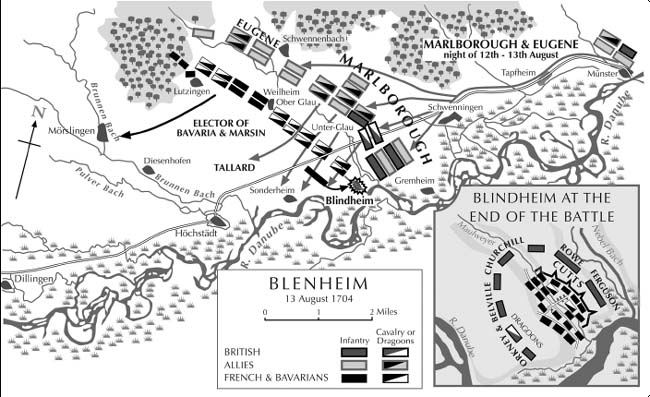
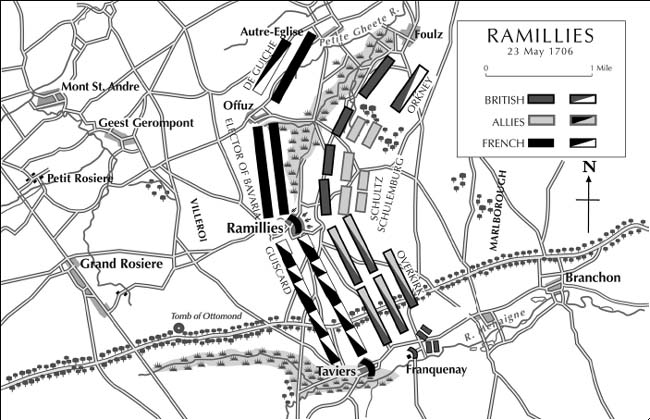
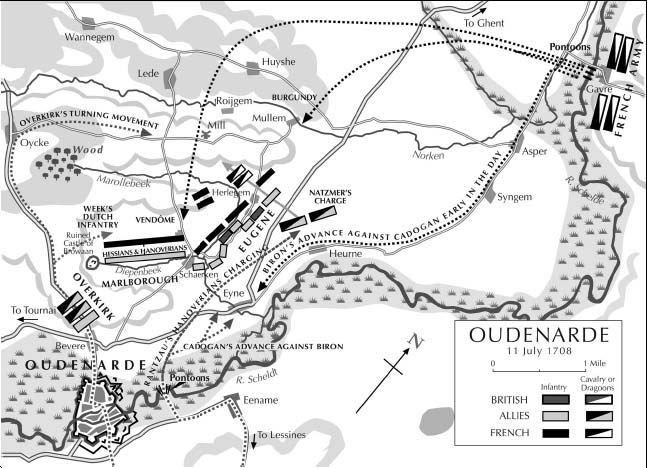
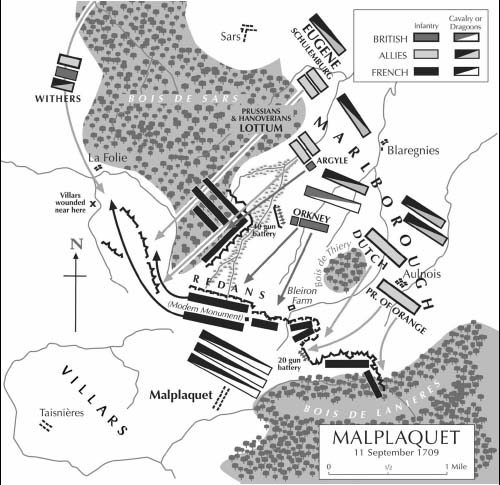
To Flanders, Portugal and Spain
Queen Anne commands and we obey
Over the hills and far away
Courage boys, tis one to ten
That we return all gentlemen
To whore and rant as well as they
When over the hills and far away.
Any army is a war machine, and whether it achieves success or failure, or is used for good or ill, that is its only purpose. First and foremost, however, an army is what its commander is if the commander succeeds, then so too does the army with laurels and glory to match, but if he fails, then the army is in consequence led to ruin and disgrace. Accordingly, this book must primarily be about Queen Annes Captain-General, John Churchill, First Duke of Marlborough, and his famous exploits as a military commander during the War of the Spanish Succession between the years 1702 and 1711. However, the story must plainly also be about the men whom the duke was entrusted to lead into battle by England (Great Britain, as it was known from the Act of Union in 1707 onwards) and the States-General of Holland. Those troops made up the only effective military force in northern Europe that could take the field to face the French, and so, just as the dukes fortunes were the fortunes of his men, so too were they the fortunes of those two countries and their allies at a time of acute European crisis. Of Marlboroughs unsurpassed record of success it was said in perfect truth that He passed all the rivers and lines that he attempted, took all the towns he invested, won all the battles he fought, was never surprised by the enemy, was ever beloved by his own soldiers and dreaded by those of the enemy.
That his troops were led to astonishing and unprecedented victories in Germany and the Low Countries will soon be seen, but we should also look at just who and what that army was, how it was gathered together, equipped, trained, administered and supplied, and how the soldiers campaigned and how they lived, whored and ranted, as the old scurrilous rhyme had it, and how they died.
This is not intended to be a simple account listing in detail the composition and structure of the Duke of Marlboroughs army at that time of war, for it was an ever-changing picture with complexity enough to gladden the heart of any Byzantine scholar, and at this remove of time the glass has darkened and the intricate detail is far from clear. What this book intends to do, rather, is to set out why that army was a war machine a resoundingly winning machine at that and how it moved, breathed, lived and, under the masterful hand of Marlborough, struck in deadly fashion at its opponents during almost ten years of hard campaigning. Those long years saw the war machine that the duke commanded, inspired with confidence and led from victory to victory, effectively laying the foundations for a military, and militant, reputation and legacy for Great Britain in particular that lasts to the present day. The duke showed his often-astonished countrymen what could be achieved, and while their opinions of him and suspicions of his vaulting ambitions might vary, the wider lesson of what they as a nation might become was not lost on them.
Marlboroughs army, his war machine, achieved success on an almost unparalleled level; at the time, certainly, its exploits in humbling the armies of King Louis XIV of France were regarded as a true wonder. In part, this was because until only a few years before the outbreak of the war for Spain, England had been regarded as a relatively negligible military entity, seemingly irrelevant and riven by internal dissent and fractious civil wars. The exploits of Cromwells well-disciplined New Model Army, which had achieved so much in the mid-seventeenth century, were disregarded, particularly as the dilettante and dissolute Restoration years of King Charles II saw marked military decline and cynical opportunism. That wily and impecunious monarch allied himself, both openly and covertly, to the French king in return for subsidies in ready cash, and English regiments were loaned into the French service to fight the Dutch and the Spanish, depending upon which opponent Louis XIV was engaged with at any particular time. It is true that these troops gained a good reputation for themselves as tough fighters, and handsome young John Churchill, who would one day become the Duke of Marlborough and a scourge of French army commanders, fought as a junior officer in these campaigns and was noted for his gallantry on more than one occasion, attracting the attention of Louis XIV. He was even offered a commission in the French army, but declined as a non-Roman Catholic could hardly hope to rise far in the service of the Sun King.the English troops, however, did not match that of the more battle-experienced Dutch, nor was their administration and logistical ability of the same high order. The States-General of Holland, of course, had learned hard lessons in the long years of their own war for independence from Spain, lessons reinforced when they were attacked by their erstwhile ally, France, and brought so close to complete ruin in the 1670s.

